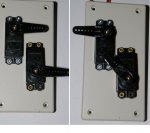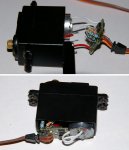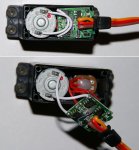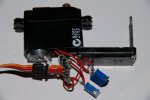westaust55
Moderator
I had purchased a couple of 6V Servo's from Jaycar a while back and after some research to ascertain the correct connections (which lead to my separate "tutorial") today I conencted them up and did some simple tests.
The findings so far:
1. Rated at 6Vdc and on no-load operate happily from 4.5Vdc.
2. Did a test using a single 4.5Vdc supply for the PICAXE (08M) and the Servo motor without experiencing any resetting problems that I have read about. However in general I will be running from a separate supply.
3. These Jaycar Servos (both the YM2763 and YM2765 - made by Hobby Tech) operate exactly the same. Jaycar have no datasheets for them and when I asked what the output shaft rotational range was, the Jaycar (Perth) sales reps first stated they were 270 degree but then turned the output shaft by hand and found they had just over 180 degree of mechanical travel and thus stated they were 180 degrees operation.
4. While most information on the internet suggests that the shorter pusle duration moves the shaft anticlockwise, these Jaycar Servos move clockwise with shorter pulses.
5. My checks by gradually increasng the range of the control pulses found that:
(a) the "nominal" angular range might likely be 120 degrees
(b) they both can operate through 142 degrees
(c) the minimum pulse duration is 0.64 ms (SERVOPOS setting = 64)
(d) the maximum pulse duration is 1.99 ms (SERVOPOS setting = 199)
(e) relative to a nominal "neutral position at 1.5ms, they move roughly 90 degrees clockwise and 52 degrees anticlockwise.
Not exactly what I was expecting in terms of balanced rotation either side of the "neutral" (1.5ms) position.
Being new to using Servos, any thoughts or comments from those more experienced in Servo operation in relation to the above would be appreciated.
The findings so far:
1. Rated at 6Vdc and on no-load operate happily from 4.5Vdc.
2. Did a test using a single 4.5Vdc supply for the PICAXE (08M) and the Servo motor without experiencing any resetting problems that I have read about. However in general I will be running from a separate supply.
3. These Jaycar Servos (both the YM2763 and YM2765 - made by Hobby Tech) operate exactly the same. Jaycar have no datasheets for them and when I asked what the output shaft rotational range was, the Jaycar (Perth) sales reps first stated they were 270 degree but then turned the output shaft by hand and found they had just over 180 degree of mechanical travel and thus stated they were 180 degrees operation.
4. While most information on the internet suggests that the shorter pusle duration moves the shaft anticlockwise, these Jaycar Servos move clockwise with shorter pulses.
5. My checks by gradually increasng the range of the control pulses found that:
(a) the "nominal" angular range might likely be 120 degrees
(b) they both can operate through 142 degrees
(c) the minimum pulse duration is 0.64 ms (SERVOPOS setting = 64)
(d) the maximum pulse duration is 1.99 ms (SERVOPOS setting = 199)
(e) relative to a nominal "neutral position at 1.5ms, they move roughly 90 degrees clockwise and 52 degrees anticlockwise.
Not exactly what I was expecting in terms of balanced rotation either side of the "neutral" (1.5ms) position.
Being new to using Servos, any thoughts or comments from those more experienced in Servo operation in relation to the above would be appreciated.
Last edited:




